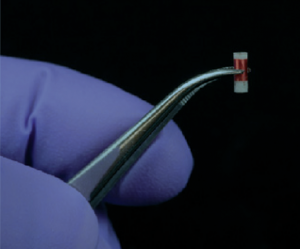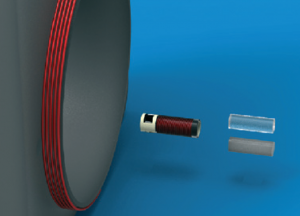For effective treatment of many illnesses, in particular cancer, long-term monitoring of certain biomarkers is required. A needle probe with a chemically sensitive tip can be used, however this is invasive as it has to be inserted every time a new measurement is taken. There are also issues with tissue heterogenicity, as it is possible that changes in the measurements are solely due to a different local environment within the tissue.

Size of sensor
Previously the Cima lab at MIT reported an improved alternative for long-term in vivo monitoring. A capsule containing an NMR contrast agent was inserted in vivo and measurements were recorded using an MRI scanner. They have now done one better and eliminated the need of very costly MRI equipment by developing a small NMR sensor that simply requires a small external reader coil.
Both the sensor and reader contain a circuit with a coil and when both are in range magnetic inductance occurs, causing field amplification inside the chamber of the sensor. This effectively means that a reading is taken only from tissue within the sensor, rather than surrounding tissue, and this is responsible for the high selectivity seen.

Different components of the system
In order to test their wireless sensor, Cima and coworkers separately measured pH and oxygen tension, both in vivo and in vitro. For the pH experiments, a polymer gel was used as the NMR contrast agent that had an exchangeable H atom with an appropriate pKa value. Using a tumor mouse model, pH readings were found to be lower when the sensor was nearer the tumor, as expected from the acidic nature of tumors. For the oxygen experiments, silicone was used as the contrast agent. The paramagnetic nature of molecular oxygen alters the relaxation time and this can therefore be used to determine the concentration of oxygen in the sensor.
From the success of their experiments, the authors conclude that they have demonstrated the flexibility of the sensor with these two measurements, and indeed there is huge potential for this NMR probe to greatly simplify in vivo monitoring.
To download the full article for free* click the link below:
Miniaturized, biopsy-implantable chemical sensor with wireless, magnetic resonance readout
C. C. Vassiliou, V. H. Liu and M. J. Cima
Lab Chip, 2015, 15, 3465-3472
DOI: 10.1039/C5LC00546A
—————-

About the webwriter
Claire Weston is a PhD student in the Fuchter Group, at Imperial College London. Her work is focused on developing novel photoswitches and photoswitchable inhibitors.
—————-
*Access is free until 01/10/2015 through a registered RSC account.










